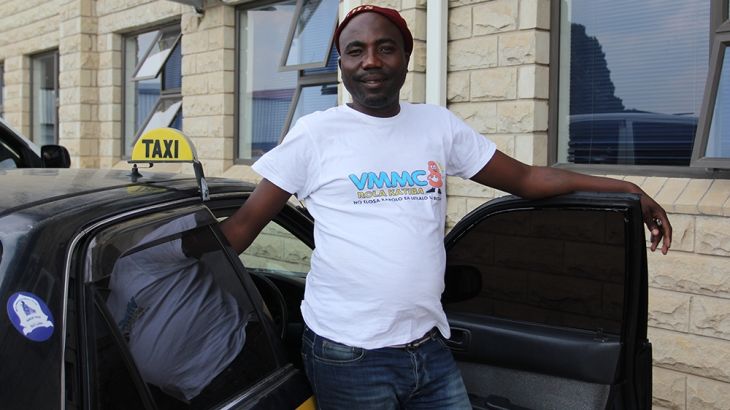Lesotho taxi drivers help lead fight against HIV
In Lesotho, country with second highest HIV rate, passengers learn about how male circumcision helps prevent infection.

Maseru, Lesotho – Tsitso Mokale drives down Moshoeshoe Road in his black taxi with a yellow stripe, scanning the pavement for potential passengers.
The taxi driver in Lesotho’s capital, Maseru, is on a mission not just to find new customers, but to start a conversation about the benefits of male circumcision and HIV prevention.
Keep reading
list of 4 itemsUS to consider visa restrictions over Uganda anti-gay law
US relaxes restrictions for gay, bisexual men to donate blood
Biden administration appeals US ruling on health coverage mandate
It is a daunting task in a country with the second-highest HIV prevalence rate in the world and where social norms and cultural restraints often prevent men from accessing health services.
“It’s sometimes difficult to talk to the older [male passengers],” Tsitso says. “Some of them say they are afraid.”
But for Mokale and more than 200 other taxi drivers across the city who are part of a programme aimed at HIV prevention, educating passengers about male circumcision has real benefits.
According to the World Health Organization (WHO), voluntary medical male circumcision (VMMC) can reduce the risk of female-male HIV infection by 60 percent.
READ MORE: Living with HIV – ‘There is nothing to fear’
There are approximately 26,000 new HIV infections a year in Lesotho, a country of more than two million people that is entirely surrounded by South Africa.
The driver mobilisation programme, which was formed through a partnership between Lesotho’s Ministry of Health, USAID and Jhpiego, a US-based health non-profit that has implemented the initiative, aims to equip drivers with the knowledge needed to educate young men about HIV prevention.
“The taxi drivers are the people who encounter the most people on a daily basis,” Polo Motsoari, a communications manager with Jhpiego, says.
The programme is part of a wider national campaign called Rola Katiba, or “take your hat off”, that focuses on educating men between the ages of 15 and 29 in an effort to reduce HIV rates.
![Lesotho has the second highest HIV prevalence rate in the world [Ali Rae/Al Jazeera]](/wp-content/uploads/2017/05/b6687dc394de44e4b5a82061529dc448_18.jpeg)
As Mokale drives around, looking for new passengers, he rolls out the list of benefits of VMMC.
“You can reduce your risk of contracting HIV, other [sexually transmitted] diseases, penile cancer … cervical cancer. There are lots of benefits,” he says.
Since 2007, the WHO and UNAIDS have recommended VMMC as a key component of HIV prevention.
READ MORE: Swaziland and HIV – Redrawing what it means to be a man
According to the WHO, VMMC works because the foreskin is an area of the body that can easily be torn to create tiny gateways for the virus to enter the body. Its removal, reduces the risk of the virus spreading.
If a passenger is interested in undertaking VMMC or learning more, Mokale and the other drivers give them a referral ticket to take to a clinic for a free consultation and procedure.
Men can opt for either a surgical or non-surgical procedure. The most popular option is called Prepex, a non-invasive method that leaves a small device on the penis for seven days in order to stop the blood flow to the foreskin. Once the skin is dead, it is cut off.
READ MORE: Mass circumcision drive in Rwanda to curb HIV
More than 11 million men have received VMMC services across eastern and southern Africa since 2008.
In Lesotho alone, more than 136,000 men have been circumcised through the Rola Katiba programme.
While VMMC does not offer complete protection – and should be used in conjunction with regular safe-sex practices – it remains one of the most cost-effective tools for HIV prevention available today, according to the WHO.
USAID and the WHO estimate that one HIV infection will be averted for every five to 15 male circumcisions completed.
‘I’m fully circumcised and I’m ok’
Despite the known benefits, taxi driver educators say it is often the stigma and misconceptions surrounding male circumcision that turns many away.
“Some people say they will never go to a clinic because we are going to cook their foreskins,” Moholi Mosebetsi, another taxi driver educator, says.
“So, we have so many things to explain to them.”
![More than 136,000 men have been circumcised as part of Lesotho's national programme aimed at reducing HIV [Ali Rae/Al Jazeera]](/wp-content/uploads/2017/05/cbf225c7deae4cdbbb33d4f652f8d210_18.jpeg)
In addition to overcoming misconceptions, Mosebetsi says another challenge is that the word in Sesotho for going through a traditional adolescent initiation ceremony – “lebollo” – is very similar to the word for circumcision.
A 2011 study published in the journal PLOS One found that nearly a quarter of men in Lesotho who self-reported as circumcised did not have evidence of circumcision. Instead, it is likely they undertook a ritual process where the foreskin was only cut, or partially removed.
This is why Jhpiego and the government have tried to find new ways to reach these young men.
“Some men don’t want to discuss sexual reproductive health with women or with someone younger. They want to discuss that with their peers,” Motsoari says.
“We are trying to venture [onto] different platforms where we can reach out to these men – regardless of their background, regardless of their age – they should all know that circumcision is here for them – and it’s free.”
READ MORE: South Africa’s plan to tackle HIV among sex workers
The volunteer taxi driver-educators are paid by Jhpiego. They receive 300 loti ($23) for every five clients they refer to a free clinic.
The initiative is set to expand further, with more taxi drivers being trained later this year.
“I’m happy because I just want people to live without sickness,” Mosebetsi says.
“I am not a doctor, but I’m fully circumcised and I’m okay.”
Ali Rae reported from Lesotho with the help of the International Reporting Project (IRP).